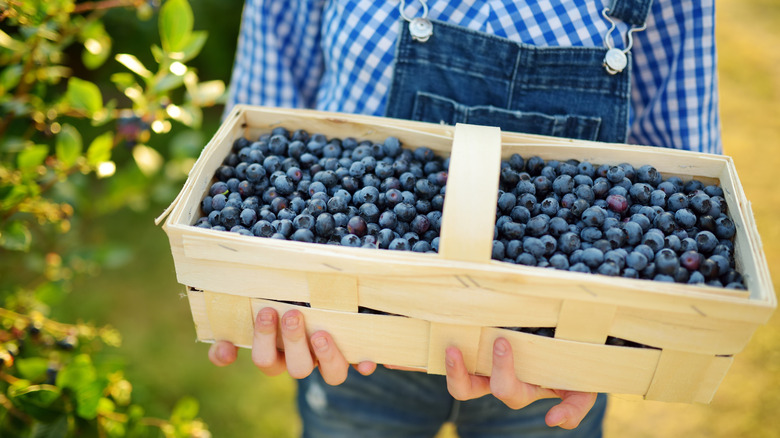Why Farmers Almost Gave Up On Blueberries
Imagine a world without commercially grown blueberries. It can make you feel a little blue, huh? Think of all the blueberry cobblers, jams, juices, muffins, pancakes, pies, smoothies, and tarts everybody would miss out on. Consider the health benefits people would lose; per the U.S. Highbush Blueberry Council, blueberries are good for the brain, cardiovascular system, and digestion. Blueberries also contain many antioxidants, fiber, and vitamins, per Britannica. It turns out we were closer to this dark alternate reality than might seem possible given the ubiquity of this blue fruit today.
We enjoy many types of blueberries, and "blueberry plant" could refer to several different shrubs. These berry bushes are native to North America, so their culinary history precedes the large-scale cultivation we are used to. Native Americans foraged for them in ancient times, not only eating the berries fresh but also including them in stews and other foods, as noted by Illinois Extension. However, it wasn't until the 20th century that blueberries as we know them began to take form — and it was not easy for those involved.
Getting blueberries off the ground
Roughly a hundred years ago, the only reliable way to gather blueberries was still to forage in the forest, per The Atlantic. This was because cultivating them in the field by planting seeds proved to be unbelievably hard for farmers of old. Nonetheless, in the early 1900s, botanist Frederick Coville and farmer Elizabeth White teamed up to raise the first domesticated blueberry crop; however, it took them five whole years to get sellable berries, says the U.S. Highbush Blueberry Council. Even then, it wasn't until the mid-20th century that the blueberry boomed, and the crop became a full-fledged part of the fresh produce industry. The key was transplanting the berry bushes from the woods into sunny fields, while ensuring that the new soil was suitable, according to Illinois Extension.
Blueberry breeding, harvesting, and packing techniques have improved so much that this crop is now the second-most commonly grown berry in the U.S., the first being strawberries. Thriving in acidic and moist yet well-drained soil, the fruit is most often produced in states with cool climates, such as Maine, Michigan, New Jersey, Oregon, and Washington nowadays (via Britannica). Usually, this takes the form of the highbush species, but others, like southern rabbiteye, grow in warmer, southern states. This growth goes on outside of the U.S., even beyond the Americas. Yes, blueberries certainly have come a long way!

